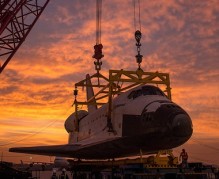Responding to mild U.S. sanctions on Russia, Deputy Prime Minister Dmitry Rogozin announced on May 13 that U.S. astronauts would no longer be welcome to ride to the International Space Station (ISS) aboard Russian rockets. “After analyzing the sanctions against our space industry, I suggest the U.S. delivers its astronauts to the ISS with a trampoline,” said Rogozin.
The taunt is witless. But the truth behind it is incontestable. Obama administration space policy has wrung the manned element out of the U.S. space program with few alternatives, save Russia’s good will, to loft American astronauts into space.
American astronauts depend on Russian Soyuz rockets for transportation to the ISS now and in the foreseeable future because President Obama decided in 2010 to end NASA’s Constellation program. Constellation was a five year-old effort into which $9 billion dollars had been invested at the time of its cancellation. It would have replaced the ageing, accident-prone, and now-retired space shuttle with new rockets and a wingless spacecraft that could place astronauts in low-earth orbit—where the ISS circles the earth—and transport them to the moon where NASA intended to establish a permanent colony for exploration as well as a possible platform for launching American astronauts to Mars.
Demonstrating a surprising and uncharacteristic faith in the private sector, Obama initially set aside 1/340th of NASA’s $17 billion dollar budget for entrepreneurs to develop vehicles for manned space travel. This political sleight-of-hand worked. Republicans who would ordinarily have objected to an extended disruption of manned space flight because it would appear to diminish American leadership in space objected less than they did when in a parallel maneuver Obama appointed a Republican senator, Chuck Hagel, to be secretary of defense. Manned space flight is expensive because it demands redundant systems that can supply human needs and protect them against such perils as cosmic radiation and the effects of prolonged weightlessness. Since the decision to end Constellation, NASA has increased the money it invests in commercial solution to about 4 percent of its current budget. The money that went into the Apollo lunar program in 1969, the year that men first landed on the moon, amounted to 54 percent of NASA’s budget. So, private entrepreneurship or not, the next time NASA plans to send American astronauts into space aboard a large world-class American rocket is at a yet-to-be scheduled time in the 2020s.
But for now a public letter authored by three Americans who walked on the moon, Eugene Cernan, Jim Lovell, and the late Neil Armstrong has been proven correct. When the Obama administration cancelled the Constellation program in 2010 they wrote that, “America’s only path to low Earth orbit and the International Space Station will now be subject to an agreement with Russia to purchase on their Soyuz (at a price of over $50 million dollars per seat with significant increases expected in the near future—note: the cost is now $71 million per seat) until we have the capacity to provide transportation for ourselves.”
Absurdities multiply in this slow descent from the prestige that the U.S. enjoyed as a result of President Kennedy’s determination that America should land on the moon first. When the 2008 Obama campaign announced that it would cut funds for space exploration it added that money could be better spent on education. They hadn’t done their homework. American graduate degrees in engineering rose and fell in concert with the manned space program achieving a high point in the same year that Apollo 11’s lunar lander, Eagle, landed on the Sea of Tranquility. The shield that protects the spacecraft on its very high-speed return through the atmosphere is one of manned space flight’s many challenges, especially beyond low-earth orbit. There is no federal program besides manned space flight that is more certain to encourage cutting-edge technology and increase the demand for advanced degrees in engineering. And the hiatus in manned space exploration until some unspecified date in the future encourages the departure of the skilled base of scientific/technological expertise that will have to be built again if the U.S. decides to reconstruct a manned space program to equal the nation’s previous achievements.
In the meantime we will remain dependent on Russia. To the hollowing out of the U.S. military, a rebalance to Asia that an Obama Defense Department official in a moment of candor admitted the U.S. military cannot support, the bluster of broken red lines, and diplomacy that is incapable of repairing, the breaks must now be added the indignity of the Russian official’s taunt that the U.S. should consider trampolines to send its astronauts into space. It’s a disgrace.
© 2014 Weekly Standard LLC. Reprinted with permission.
